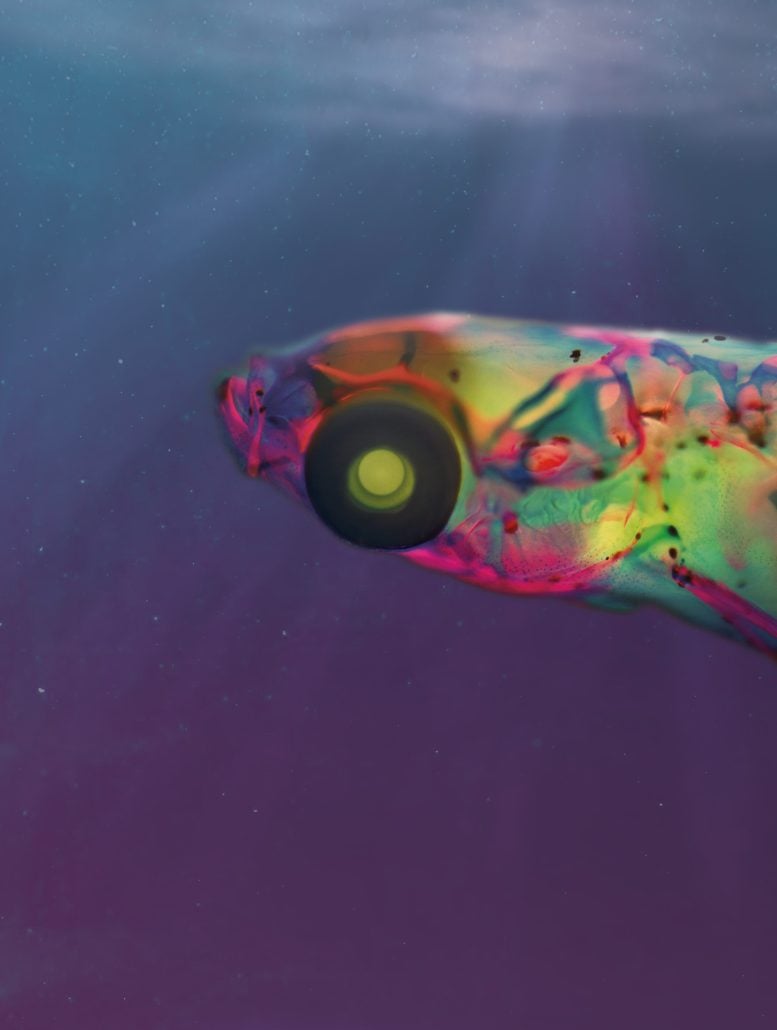
How Danionella cerebrum Hears What Humans Can’t
-
by Anoop Singh
- 8

Researchers at Charité have solved the puzzle of directional hearing underwater.
When underwater, humans cannot determine where a sound comes from. Sound travels about five times faster there than on land. That makes directional hearing, or sound localization, nearly impossible because the human brain determines the origin of a sound by analyzing the time difference between its arrival at one ear versus the other.
By contrast, behavioral studies have shown that fish can locate sound sources such as prey or predators. But how do they do it? Neuroscientists from Charité – Universitätsmedizin Berlin have solved the puzzle, describing the auditory mechanism of a tiny fish in the journal Nature.
It has quite a grand name for such a tiny creature: Danionella cerebrum, a fish measuring about 12 millimeters, nearly entirely transparent for its whole lifetime, native to streams in southern Myanmar. Danionella has the smallest known vertebrate brain, but it still displays a number of complex behaviors, including communicating by sound. That, and the fact that scientists can see directly into its brain – the head and body are nearly transparent – make it interesting for brain research.
Prof. Benjamin Judkewitz, a neurobiologist with the NeuroCure Cluster of Excellence at Charité, and his team are using the tiny fish as a window into fundamental questions such as how nerve cells communicate with each other. Their most recent work is dedicated to the development of the sense of hearing and the decades-old question of how fish can locate a source of sound underwater. Previous textbook models of directional hearing fall short when applied to underwater environments.
The acoustic world, above and under the water
From whale song to the chirping of birds or a predator stalking its prey, when sound is emitted from a source, it spreads to the medium around it as motion and pressure oscillations. This can even be felt by placing a hand on the cone of a speaker. There is the vibration of particles, the adjacent air is moved – this is known as particle velocity. The particle density also changes as the air is compressed. This can be measured as sound pressure.
Terrestrial vertebrates, including humans, perceive the direction of sound primarily by comparing the volume and time when sound pressure reaches the two ears. A noise sounds louder and arrives sooner in the ear closer to the source of the sound. That strategy does not work underwater. Sound spreads much faster there, and it is not muffled by the skull. That means that fish should also be incapable of directional hearing, as there is practically no difference in volume and arrival time between their ears. And yet, spatial hearing has been observed in behavioral studies of various species.
“To find out whether, and above all how, a fish can tell the direction of sound, we built special underwater speakers and played short, loud sounds,” explains Johannes Veith, one of the two first authors of the current study. “Then we analyzed how often Danionella avoids the speaker, meaning that it recognizes the direction the sound is coming from.” For the analyses, a camera was used to film every fish from above and track its exact position. This live tracking method brought a crucial advantage: the team was now able to zero in on echoes and suppress them.
Fish hear completely differently
What humans perceive through the eardrum is sound pressure, not particle velocity. Fish have a completely different hearing mechanism: They can perceive particle velocity, too. How exactly this works in Danionella was revealed by images taken with a purpose-built laser scanning microscope that scans the structures inside the fish ear in a strobe pattern while a sound is played.
Close to an underwater speaker, water particles move back and forth along an axis oriented toward and away from the speaker. The particle velocity moves along the direction in which the sound spreads. A fish close to the speaker also moves with the water, but tiny stones in the inner ear known as otoliths are slower to move due to inertia. This results in a tiny motion detected by sensory cells in the ear. The problem is that this means the fish can only detect the axis along which the sound moves – but not the direction from which it comes. This is because sound is a form of oscillation, a continuous back-and-forth movement.
This problem is solved by analyzing particle velocity depending on the current sound pressure – one of the various hypotheses that sought to explain the mechanism involved in directional hearing in the past. It turned out to be the only theory that fit the researchers’ results: “Sound pressure sets the compressible swim bladder in motion, which in turn is recognized by hair cells in the inner ear. Through this second, indirect hearing channel, sound pressure gives fish the reference they need for directional hearing. That’s exactly what one model of spatial hearing from the 1970s predicted – and now we’ve confirmed it experimentally,” Judkewitz says. The team was also able to show that directional hearing can be fooled by reversing the acoustic pressure. When that was done, the fish swam in the opposite direction, meaning toward the source of sound.
Micro-CT images of the hearing apparatus in Danionella show that it is similar to the sensory organ of about two-thirds of living freshwater fish, or about 15 percent of all vertebrate species. This suggests that the directional hearing strategy that the team has now confirmed, involving combined analysis of sound pressure and particle velocity, could be widespread. The researchers plan to continue their work to determine which nerve cells specifically are activated when sounds are played underwater.
Reference: “The mechanism for directional hearing in fish” by Johannes Veith, Thomas Chaigne, Ana Svanidze, Lena Elisa Dressler, Maximilian Hoffmann, Ben Gerhardt and Benjamin Judkewitz, 19 June 2024, Nature.
DOI: 10.1038/s41586-024-07507-9
The fish moves away in response to a sound played underwater, showing that it can tell which direction the sound comes from. Credit: Antonia Groneberg, Charité and Jonathan Anand Researchers at Charité have solved the puzzle of directional hearing underwater. When underwater, humans cannot determine where a sound comes from. Sound travels about five times…
The fish moves away in response to a sound played underwater, showing that it can tell which direction the sound comes from. Credit: Antonia Groneberg, Charité and Jonathan Anand Researchers at Charité have solved the puzzle of directional hearing underwater. When underwater, humans cannot determine where a sound comes from. Sound travels about five times…
